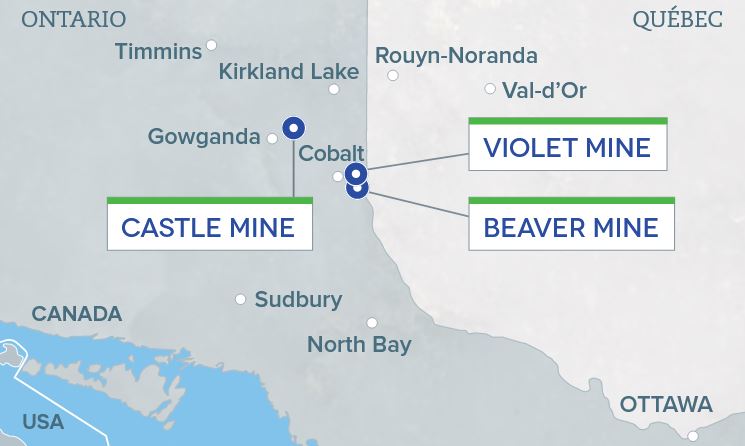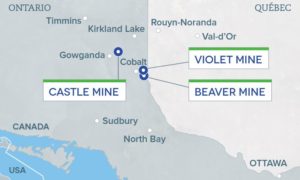Canada Cobalt Works probes new gold find

Mineral projects of Canada Cobalt Works Inc.

Canada Cobalt Works Inc., [CCW-TSXV; CCWOF-OTCQB; 4T9B-FSE], a company that is actively exploring in the historic Cobalt, Ontario camp, has reported a new gold discovery east of its flagship Castle property
The company says step-out drilling, 1.5 km east-northeast of the Castle property, has intersected an apparent syenite-hosted gold system.
Two widely-spaced holes were drilled, with both encountering near-surface gold mineralization.
“Drill holes CS-18-15, CS-18-16 and CS-18-16-W (wedge hole) east of the mine are a very important breakthrough and now have us seriously investigating an apparent gold system with appropriate sulphide and quartz veining in association with a major fault that may be the controlling fault for the zones we’ve encountered,” said Doug Robinson, a consulting geologist to Canada Cobalt.
The discovery of near-surface gold mineralization east of the Castle Mine doesn’t rule out the possibility of finding silver/cobalt mineralization in this new zone, as well, beneath this layer of gold mineralization, Robinson said.
Canada Cobalt Works’ key asset is a 3,300-hectare property formerly known as the Castle Silver Mine. The property is a past-producing silver mine located near the northern Ontario community of Gowganda, 85 km north of the historic Cobalt Silver Mining Camp. It also owns the past-producing Beaver and Violet mines near the city of Cobalt.
The company is headed by President and CEO Frank Basa. In the early 1980s, Basa worked for Agnico-Eagle Mines Ltd. [AEM-TSX, NYSE] at the Castle Mine as a metallurgical engineer, processing ore from Castle and other mines in Ontario’s cobalt-silver camp. During that time, he developed the RE-20X Process with the National Research Council and they engineered a process that could separate both the cobalt and the silver form a mixed concentrate.
However, that processing success occurred in the late 1980s. So Agnico-Eagle never applied Re-20X commercially.
Since Agnico turned its attention to gold, Basa and his team have refined the Re-20X process further. They are now testing the process at SGS Lakefield to see if it works for extracting cobalt, lithium and other metals from used lithium-ion batteries.
“If we can show that it works, we could be in a position to open up a new line of business extracting cobalt and other metals by recycling spent lithium-ion batteries,” Basa told The Northern Miner newspaper.
Prior to the gold discovery, Canada Cobalt Works had previously announced results from drilling on the first underground level of the Castle Mine. Highlights from the first three drill holes included 2.28% cobalt, 261 g/t silver, and 1.65% nickel over 7.00 metres (hole CA 18-001), and 1.87% cobalt, 4,763 g/t silver, 1.29% nickel and 1.19 g/t gold over 2.54 metres (hole CA 18-002). The first level is only one of 11 that were previously mined.
Thanks to the electric vehicle revolution and rising demand for lithium-ion batteries, cobalt remains one of the hottest commodities in the global metals sector. However, cobalt’s main challenge is that it very rarely will justify its own project.
On Wednesday December 19, Canada Cobalt Works shares eased 1.08% or $0.005 to 46 cents. The 52-week range is 19 cents and 90 cents.
